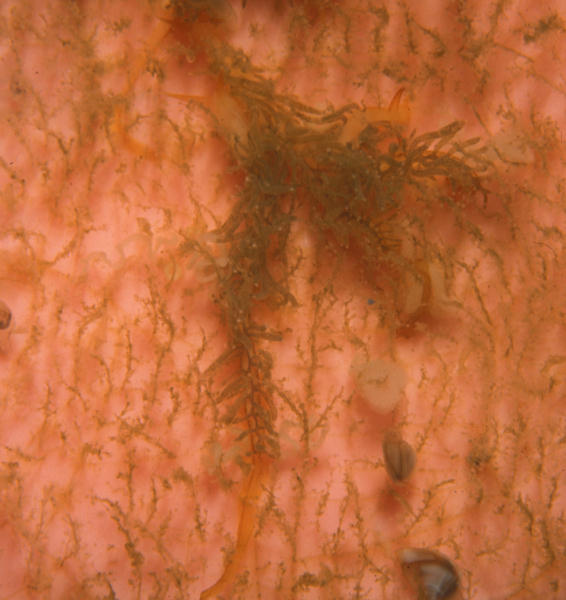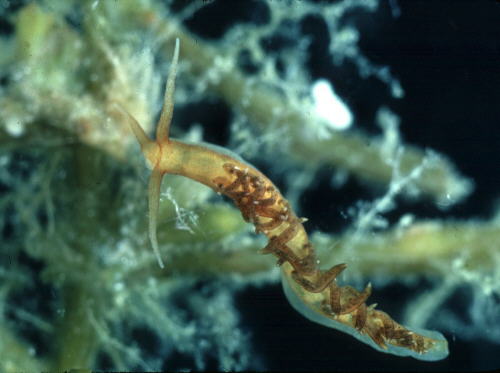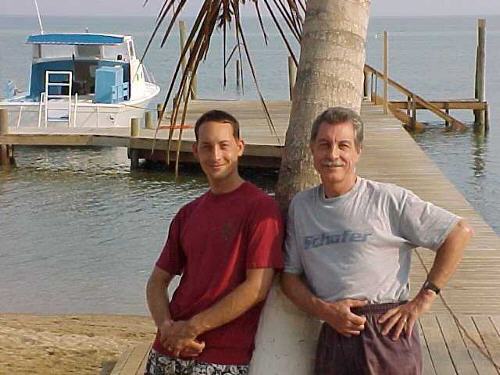 |
Cuthona phoenix Photo courtesy of Michael Behrens
Santa Cruz Island
Nov. 2002
Cuthona Phoenix
Phtoto courtesy of Jim Lance
LA Bay, Baja Calif
June 1982

Cuthona phoenix Gosliner, 1981
When my son, Mike, handed me the specimens and photo shown here I leaped for joy thinking wow, I finally get to examine Tergipes up close, remembering that I had included a photo by Jim Lance in my first edition of Pacific Coast Nudibranchs , as Tergipes sp. I had forgotten however that Terry Gosliner had later described this critter as Cuthona phoenix. Never-the-less, this is an interesting find, as this species is very rare.
Cuthona phoenix as the story goes, was one of the first living organisms to appear after the catastrophic Santa Barbara Channel oil spill in the 1969. It was actually found on chunks of floating solidified asphalt, after the spill. To eulogize the event, Terry named the species (phoenix) by latinizing the name of the bird from Egyptian mythology which rose from its own ashes to renew its life. How fitting.
Mike's specimens, here, are from the same area in the Channel Islands - specifically Santa Cruz Island. These specimens were collected from a drifting fisherman's buoy. The buoy was covered with Cuthona phoenix's favorite food, the tiny campanulariid hydroid, Gonothyraea serialis. As Gosliner points out, this flotsam existence is similar to that of Fiona pinnata, a cosmopolitan nudibranch species also present in the area. Fiona feeds on the gooseneck barnacle, Lepas , as well as chondrophores and siphonophores.
We had always thought this species to belong to the genus Tergipes because it has only a single ceras on each ceratal row. Gosliner placed it in Cuthona however stating that the similarities where greater to Cuthona than Tergipes.
Cuthona phoenix has 5-7 ceratal rows with a single ceras in each. The rhinophores and head tentacles are orange-brown. The cerata have small brown flecks distributed over the surface. The digestive ducts are brown and easily seen through the skin of the animal. Mike's specimens were rather large measuring over 20 mm in length. The specimen at the left was collected by veteran brancher Jim Lance at Bahia de los Angeles (LA Bay) in the early 80's.
Jim was kind enough to provide images highlighting the animals internal anatomy and its characteristic coiled egg mass .
Reference:
Gosliner, T.M. 1981. A new species of Tergipedid nudibranch from the coast of California. J. Moll. Stud. 47: 200-205.
Dave Behrens
Danville, Calif
Dec. 2002
Taxonomic information courtesy of:

Mike and Dave Behrens
Author:
Pacific Coast Nudibranchs
Co-Author Coral Reef Animals of the Indo Pacific
Propriator of Sea Challengers Natural History Books !
Send Dave mail at seachalleng@earthlink.net
© The Slug Site, Michael D. Miller 2002. All Rights Reserved.

Santa Cruz Island
Nov. 2002
Cuthona Phoenix
Phtoto courtesy of Jim Lance
LA Bay, Baja Calif
June 1982

|
Cuthona phoenix Gosliner, 1981 When my son, Mike, handed me the specimens and photo shown here I leaped for joy thinking wow, I finally get to examine Tergipes up close, remembering that I had included a photo by Jim Lance in my first edition of Pacific Coast Nudibranchs , as Tergipes sp. I had forgotten however that Terry Gosliner had later described this critter as Cuthona phoenix. Never-the-less, this is an interesting find, as this species is very rare. Cuthona phoenix as the story goes, was one of the first living organisms to appear after the catastrophic Santa Barbara Channel oil spill in the 1969. It was actually found on chunks of floating solidified asphalt, after the spill. To eulogize the event, Terry named the species (phoenix) by latinizing the name of the bird from Egyptian mythology which rose from its own ashes to renew its life. How fitting. Mike's specimens, here, are from the same area in the Channel Islands - specifically Santa Cruz Island. These specimens were collected from a drifting fisherman's buoy. The buoy was covered with Cuthona phoenix's favorite food, the tiny campanulariid hydroid, Gonothyraea serialis. As Gosliner points out, this flotsam existence is similar to that of Fiona pinnata, a cosmopolitan nudibranch species also present in the area. Fiona feeds on the gooseneck barnacle, Lepas , as well as chondrophores and siphonophores. We had always thought this species to belong to the genus Tergipes because it has only a single ceras on each ceratal row. Gosliner placed it in Cuthona however stating that the similarities where greater to Cuthona than Tergipes. |
Reference:
Gosliner, T.M. 1981. A new species of Tergipedid nudibranch from the coast of California. J. Moll. Stud. 47: 200-205.
Danville, Calif
Dec. 2002
Taxonomic information courtesy of:

|
